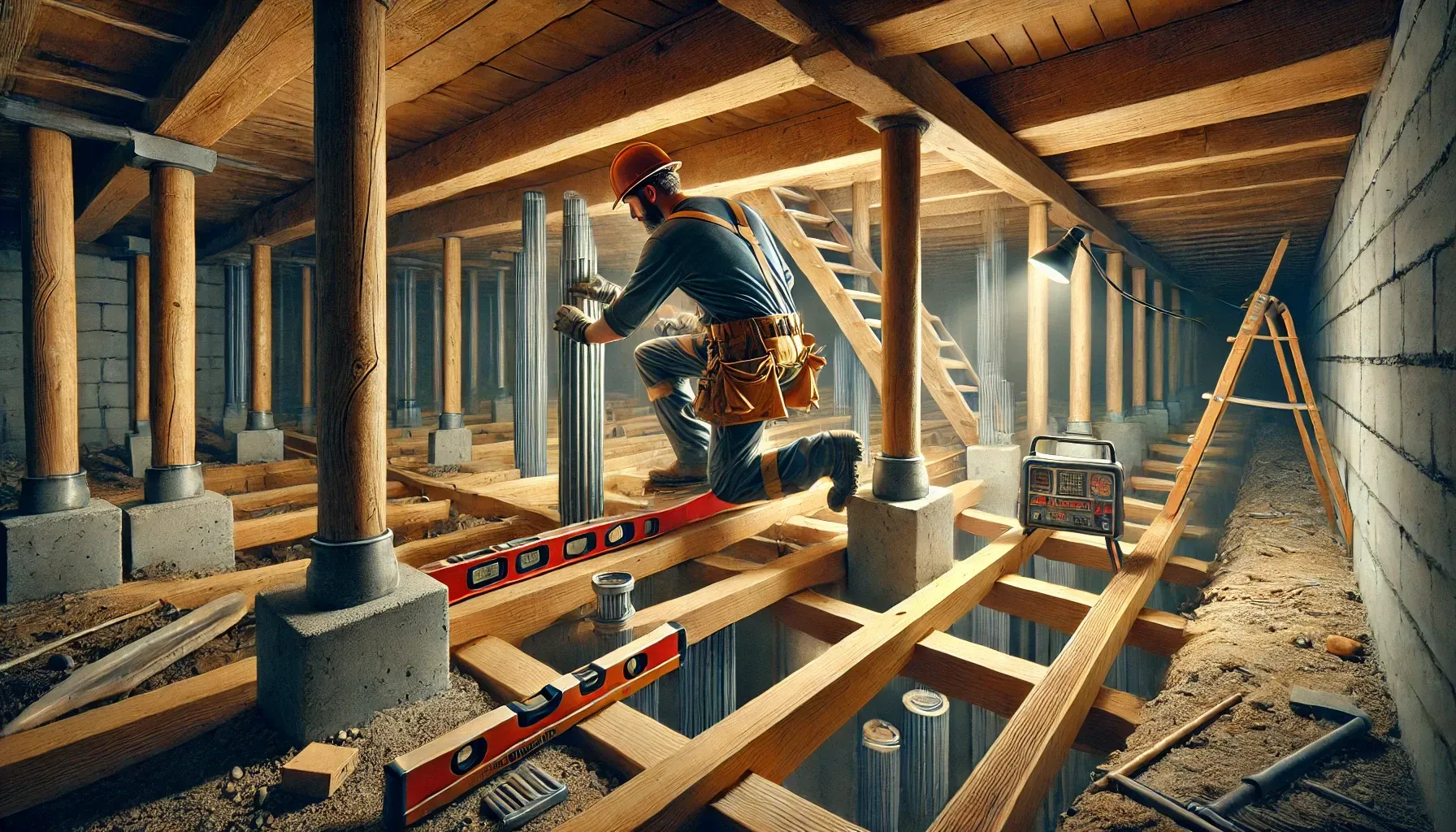What is Pier and Beam foundation, Common issues, Benefits and More.
Pier and Beam Foundations: Benefits, Common Issues, and Expert Repair Solutions for a Stronger Home
When it comes to keeping your house sturdy and upright, your foundation is doing some seriously heavy lifting, both figuratively and literally.
Among the many types of foundations out there, the pier and beam foundation holds a special place. Not only is it a classic option for homes, but it also has quirks, benefits, and (let’s be real) a few issues that make it uniquely charming.
So, what is a pier and beam foundation? In layman's terms, this type of foundation relies on a series of vertical supports (piers) that hold up horizontal beams.
These beams, in turn, support the floor joists and structure of your home. Think of it as your house getting a sturdy piggyback ride from these dependable piers.

A Brief History of Pier and Beam Foundations
Back in the day, especially before the rise of concrete slab foundations, pier and beam systems were the go-to solution for homes.
They were particularly common in areas prone to flooding or with expansive soil. Why? Because they offer elevation and flexibility. It's like your home has its own stilts, a safety net when Mother Nature decides to throw a tantrum.
During the 19th and early 20th centuries, pier and beam foundations were especially prevalent in areas with challenging climates and soil types.
Builders loved the fact that these systems allowed for better air circulation beneath the home, reducing the risk of mold and moisture problems.
This design also made it easier to perform repairs on plumbing and electrical systems, as workers could simply access the crawl space without tearing into floors.
Today, this type of foundation is still popular, especially in older homes and regions with challenging soil conditions. If your house rests on one, congratulations!
You own a slice of architectural tradition. But like any part of a home, maintenance is key to ensuring it lasts.
Where Is This Type of Foundation Commonly Found?
Pier and beam foundations aren’t just a random architectural choice, they’re purpose-built to thrive in specific environments and conditions. Knowing where they’re most common can help you appreciate their practicality and durability.
1. Regions with Expansive Soils
Expansive soils, those that shrink and swell with moisture changes, can wreak havoc on rigid slab foundations. That’s why pier and beam systems are a popular choice in areas with these challenging soil types. By elevating the structure, they mitigate the effects of soil movement, protecting the home from cracks and shifting.
For instance, states like Texas, which are notorious for their clay-heavy soils, often see homes built on pier and beam foundations. The flexibility of this design accommodates the soil’s natural tendencies to expand and contract without compromising the structure.
2. Flood-Prone Areas
If you live in a region prone to heavy rains or flooding, a pier and beam foundation might be your home’s best defense. By elevating the structure, it minimizes the risk of water damage during floods. Coastal areas, as well as regions near rivers and lakes, often feature homes with this type of foundation for precisely this reason.
For example, in parts of Louisiana and Mississippi, where flooding is a common occurrence, many homes are raised on piers to stay above high water levels. This design not only protects the home but also reduces the financial burden of water-related repairs.
3. Older Residential Neighborhoods
Pier and beam foundations were widely used before the advent of concrete slab construction. As a result, many older residential neighborhoods, especially those with homes built in the early to mid-20th century, feature this type of foundation.
Take Philadelphia, for example. Many historic homes in the city still rest on pier and beam systems. While they require regular maintenance, these foundations have stood the test of time, showcasing their durability and adaptability.
4. Areas with Uneven Terrain
Building on sloped or uneven terrain presents unique challenges. Pier and beam foundations are a practical solution in these scenarios because the piers can be adjusted to different heights, creating a level base for the home.
Mountainous regions or hilly suburbs often utilize pier and beam foundations to accommodate the natural landscape. This not only ensures stability but also minimizes the need for extensive excavation or grading, preserving the environment.
5. Regions with Poor Drainage
In areas where soil doesn’t drain well, slab foundations can trap water, leading to long-term structural issues. Pier and beam systems, on the other hand, elevate the home and allow water to flow freely beneath it, reducing the risk of damage.
For example, parts of New Jersey and Pennsylvania with high water tables often rely on pier and beam foundations to prevent water-related problems. This design ensures homes remain dry and structurally sound even in wet conditions.
By understanding where pier and beam foundations are most commonly found, homeowners can appreciate their practicality and the advantages they bring to specific environments. Whether it’s protecting against floods, accommodating uneven terrain, or adapting to challenging soils, this foundation type continues to prove its worth.
Common Issues with Pier and Beam Foundations
Ah, the pier and beam foundation, an MVP of housing support systems. But even the best players have their off days. Let’s talk about the common issues that might make your foundation feel less like a strong friend and more like a high-maintenance roommate.
1. Settling Piers
Over time, the piers can sink or shift due to soil movement. This is particularly common in areas with clay-heavy soils, which expand when wet and contract when dry. You might notice sloping floors or cracks in your walls as a result. (Pro tip: If you’re sliding toward the kitchen without moving your feet, your piers might need some love.)
Settling piers can have cascading effects on your home. When one pier shifts, the entire balance of the foundation can be thrown off. This can lead to uneven weight distribution, putting stress on beams and joists. If left unchecked, it can cause structural issues that might require extensive repairs. The good news? Professionals can stabilize or replace problematic piers, ensuring your home regains its stability.
2. Moisture Damage
Since pier and beam foundations often include a crawl space, moisture can wreak havoc. Excess moisture can lead to wood rot, mold growth, and even attract unwanted critters. Nobody wants termites taking over their beams like they’re at an all-you-can-eat buffet.
Moisture issues often stem from poor drainage or inadequate ventilation. Without proper precautions, water can accumulate in the crawl space after heavy rains or plumbing leaks.
This creates a humid environment perfect for mold and mildew. Over time, this can compromise the integrity of wooden beams and joists, leading to sagging floors or worse. Addressing moisture issues often involves improving drainage systems, sealing crawl spaces, and ensuring proper airflow.
3. Poor Drainage
Without proper drainage, water can accumulate under the house, leading to structural instability and a breeding ground for mold and mildew.
Poor drainage doesn’t just affect the foundation; it can also impact your yard and landscaping. Erosion caused by water pooling around your home can lead to further soil instability. Installing French drains, downspout extensions, or a sump pump can go a long way in mitigating these risks. Regularly inspecting your home’s drainage system is key to preventing long-term issues.
4. Sagging Floors
If the beams or joists weaken, you’ll likely notice uneven or bouncy floors. While it may feel like an impromptu trampoline session, it’s not something to ignore.
Sagging floors can be caused by a variety of factors, including wood rot, undersized joists, or deteriorated beams. Fixing this issue often requires reinforcing the existing beams or installing additional piers for extra support. The process might involve some temporary disruption to your home’s interior, but the result is a level and secure floor that’s worth the effort.
5. Critter Invasion
Let’s be real: Crawl spaces can be prime real estate for raccoons, possums, and other four-legged squatters. If you’ve heard mysterious scurrying sounds beneath your feet, it’s time to inspect.
Critter problems often arise when crawl space vents are damaged or left open. Once inside, animals can cause all sorts of trouble, from chewing on wires to leaving behind unpleasant odors. Sealing entry points and installing durable vent covers can help keep your crawl space critter-free. For existing infestations, calling a pest control professional is the safest bet.
Benefits of Pier and Beam Foundation Repair: Worth Every Penny
Foundation repair can feel like a big undertaking, but when it comes to pier and beam systems, the benefits are as solid as… well, a reinforced pier. Here’s why investing in repair is a no-brainer:
1. Improved Structural Stability
Repairing your pier and beam foundation ensures your home is safe and secure. By reinforcing the piers and beams, you’re essentially giving your house a much-needed chiropractic adjustment, minus the awkward back cracking sounds.
Structural stability is more than just peace of mind; it’s also about preventing future problems. A stable foundation reduces the risk of cracks forming in walls, ceilings, and floors. It also protects your home from the long-term effects of shifting soil, which can exacerbate existing issues if not addressed promptly.
2. Better Drainage and Moisture Control
Professional foundation repair often includes improvements to your home’s drainage system. Say goodbye to swampy crawl spaces and hello to dry, worry-free living.
Improved drainage not only protects your foundation but also benefits the overall health of your home. By channeling water away from the house, you’re reducing the risk of mold, mildew, and wood rot. Many repair professionals also offer solutions like crawl space encapsulation, which involves sealing the area with a vapor barrier to keep moisture at bay.
3. Enhanced Comfort
No more sloping floors or bouncing steps. Repairing your foundation can make your home feel level and solid again, like it’s ready to host the family holiday gathering without causing a wobbly table fiasco.
Comfort isn’t just about aesthetics; it’s about the overall livability of your home. A repaired foundation ensures doors and windows open and close properly, prevents drafts, and eliminates annoying creaks and groans from shifting floors. It’s the little things that make a big difference.
4. Increased Property Value
Thinking about selling? A stable foundation is a major selling point. Nobody wants to inherit foundation problems. Repairing your pier and beam system can boost your home’s value and make it more attractive to buyers.
Foundation issues are one of the first things potential buyers (or their inspectors) look for when evaluating a home. A repaired foundation signals to buyers that the property has been well-maintained and is free of hidden structural surprises. It’s an investment that pays off both in the short and long term.
5. Energy Efficiency
A well-maintained foundation reduces drafts and keeps your home’s insulation working as it should. This means lower energy bills and a cozier living space.
Energy efficiency might not be the first thing that comes to mind when thinking about foundation repair, but it’s a significant benefit. Sealing cracks and gaps in the foundation prevents air leakage, keeping your home warmer in winter and cooler in summer. This not only reduces utility bills but also lessens your carbon footprint.
Addressing the Big Question: How Much Do Foundation Piers Cost?
Ah, the million-dollar (or hopefully not) question. The cost of foundation piers can vary widely depending on factors like the size of your home, the extent of the damage, and the materials used. On average, homeowners might spend anywhere from $1,000 to $3,000 per pier for professional installation.
While it may sound pricey, remember that foundation repair is an investment in your home’s future. A solid foundation means fewer problems down the road, and fewer sleepless nights worrying about your home slowly turning into the Leaning Tower of Pisa.
The overall cost of repairing a pier and beam foundation depends on several variables, including the number of piers needed, the type of soil, and the accessibility of the crawl space. Additional expenses might include addressing moisture issues, reinforcing beams, or improving drainage systems. Getting a detailed estimate from a trusted contractor is the best way to plan your budget.

Imagine this: You’re mid-repair, knee-deep in mud, and suddenly realize you’ve made things worse. Avoid the headache (and the muddy boots). Search for "foundation repair near me" and let professionals handle the hard stuff.
Professional repair services offer several advantages over DIY attempts. They use advanced tools and techniques to diagnose problems accurately, ensure long-lasting results, and often provide warranties for their work. Plus, their expertise minimizes the risk of further damage, saving you money and stress in the long run.
Why We Love Pier and Beam Foundations (And You Should Too)
Despite their quirks and occasional challenges, pier and beam foundations have a lot going for them. They offer flexibility, are easier to repair than concrete slabs, and provide an accessible crawl space for plumbing and electrical work.
Plus, there’s something comforting about knowing your home has a solid support system, even if it occasionally needs a little TLC. With regular maintenance and timely repairs, your pier and beam foundation can continue being the unsung hero of your home.
Pier and beam foundations are particularly well-suited for regions with challenging soil conditions, such as areas prone to shifting or expansive clay soils. Their elevated design protects homes from flooding and allows for easy access to utilities. While they require more maintenance than slab foundations, their durability and versatility make them a worthwhile choice for many homeowners.
Final Thoughts: Strong Foundations for Happy Homes
Whether you’re already a proud owner of a pier and beam foundation or just curious about this architectural gem, understanding its benefits and challenges is key. From improved stability to better drainage and a cozier home, investing in foundation repair pays off in spades.
So, if you’re noticing sloping floors, moisture issues, or cracks, don’t wait. Reach out to trusted concrete foundation contractors or search “how to repair house foundation” to find expert help near you. Remember: A strong foundation isn’t just about your house; it’s about peace of mind, and that’s priceless.
Key Takeaways
Practical Design:
Pier and beam foundations are elevated systems ideal for homes in areas with expansive soils, uneven terrain, or flood-prone regions. They offer flexibility and protection against environmental challenges.
Common Issues:
Problems like settling piers, moisture damage, poor drainage, sagging floors, and pest invasions are typical but can be mitigated with proper maintenance and repair.
Widespread Use:
Found in older neighborhoods, areas with clay-heavy soils, and flood-prone locations, these foundations are prevalent in regions like Texas, Louisiana, and parts of Pennsylvania and New Jersey.
Benefits of Repair:
Repairing a pier and beam foundation improves structural stability, enhances comfort, increases property value, and boosts energy efficiency by sealing drafts and preventing insulation loss.
Cost Considerations:
The cost of repairing pier and beam foundations ranges from $1,000 to $3,000 per pier, depending on factors like soil type and damage severity. Additional repairs, such as drainage improvements, may add to the expense.
Professional Expertise is Essential:
Foundation repairs require professional expertise for accurate diagnoses and effective solutions. DIY attempts can worsen issues and lead to higher costs in the long run.
Timeless Value:
Despite requiring regular maintenance, pier and beam foundations are durable, adaptable, and offer long-term value when maintained, making them a smart choice for homeowners in specific environments.
Protect Your Investment from Structural Damage, Water & Mold Serving the Tri-Sate Area
PA License #PAHIC169133
DE License #2022707501
NJ License #13VH12234100
Hours of Operation
Mon to Fri 7am to 7pm
Sun to Sun: 7am - 7pm
©Philadelphia Foundation Repair & Waterproofing

